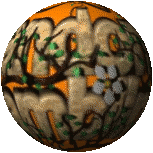England is full of wild fruit trees. They grow in woods, valleys, leas, down winding, leafy country lanes, church yards, by the tow-paths of canals, at the edges of rivers and brooks and on the odd village green, in fact almost everywhere. There is nothing quite like the bite of a wild fruit to children brought up in the countryside.
As a child living in country surroundings, I was never bored there was always too much to do. From the first crack of sunlight breaking through the sky at dawn until the bats danced above our heads in their skittish fashion, I lived in a world of magic. I like so many others went scrumping. This was a pastime that occupied many a school child during the Autumn. Boys stuffed their pockets with the tiny, tart crab apples and girls scooped up their skirts to form make-shift baskets to hold as many of the little fruits as it was possible to carry. Boys would often climb up the gnarled little trees and shake until several pounds worth of fruit bounced to the ground. When every apple that it was possible to shake off was lying on the ground everyone would stoop down and begin the job of picking them up.
Once at home the apples would be peeled and put into a large saucepan to which was added a large amount of sugar … they are very bitter apples. The jam produced, called crab apple jelly is truly delicious … it was added to porridge, rice pudding, generously dolloped onto sponge cake, hot buttered toast or pikelets. Added to fruitcake to make it rich and moist … or simply just spooned out of jars and eaten.

Picture showing crab apples growing on wild fruit trees. Collecting the fruit off these trees (apples) is called scrumping.
Fruit trees for the larder
For anyone who has struggled with getting fruit trees to thrive in their garden then grow wild ones. These are much more hardy and on the whole produce many more pounds of fruit than standard fruit trees. They are usually free of disease and require no care or attention … the perfect tree for the lazy gardener! Soft fruits are, on the whole, small but beautifully succulent and extra sweet. Firmer fruits make for the perfect compote. If you are unable to purchase wild trees – then try the old fashioned method of simply pushing a pip into the soil where you would like the tree to sprout. When planting soft-fruit trees you do need to use the stone with all of the flesh of the fruit attached. Usually, this is just semi-buried ... place the fruit into the soil with just a small amount of the top flesh showing.
All fruit when grown from seed reverts back to its wild form.
































































































